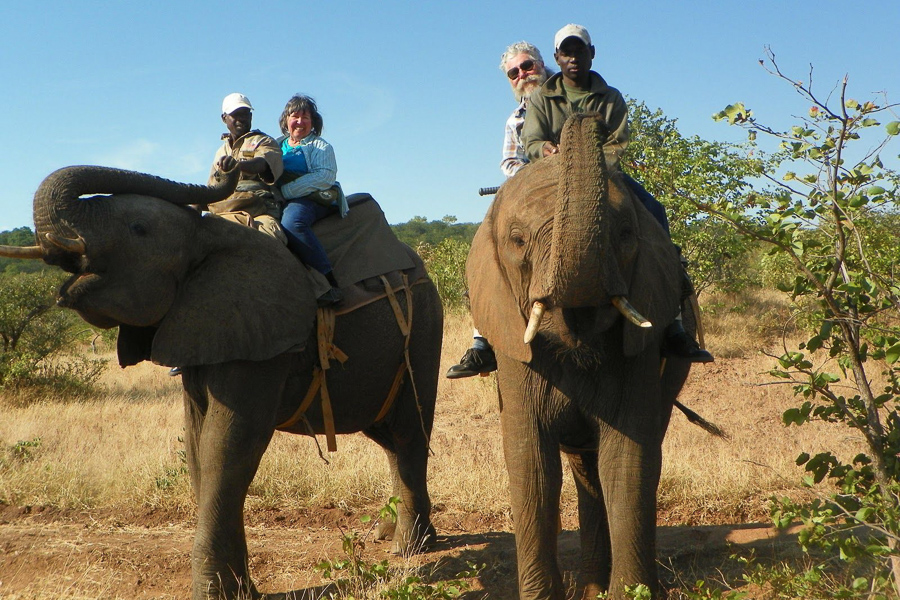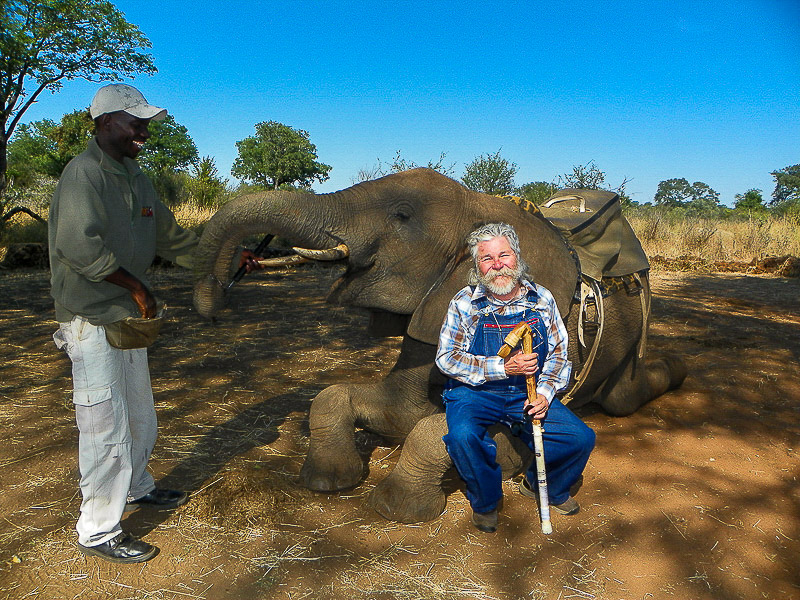
Across Eurasia the words for “elephant” are remarkably similar – Rejected
Introduction
Anecdotal record: Early in March 2013 I hurried to complete a paper for peer review and possible publication in a ZBORNIK (Journal) of a Veneti Society based in Ljubljana, Slovenia. (See below). Later in March 2013 I went on a series of safaris in South Africa, Botswana, Zambia and Zimbabwe. Quite naturally my paper and the WORDS FOR ELEPHANT were still on my mind as I rode an AFRICAN Elephant. While riding the African Elephant I indeed was looking for answers in all the right places. Riding on an Asian Elephant is rather common. Riding on an AFRICAN ELEPHANT is very rare. Just for sake of curiosity I asked what were the local words for Elephant. Imagine how exited I was when the first word which I learned for Elephant was T L O U. (I learned that word from N.M. Mateugu). To many people there would be no resemblance between TLOU and SLON. Allow me to point out the meaning behind the Slavic “ON” on the end of the word “SLON“. The Slavic word for “HE” is “ON” and ALL words which end that way (Animate or INanimate) are of Masculine Gender. Slavic examples of words ending in ON are: ZVON (BELL), HON (Czech HUNT/CHASE), KON (ACTion), ZÁKON (CONSTITUTION/LAW), KONj (HORSE), and SLON (ELEPHANT). When foreign words become part of the Slavic vocabulary they assume masculine gender if they end with ON – such as Baron, Wagon, Horizon, Bison…
The T in TLOU and the S in SLON are interchangeable. They are “dentals“. The T is produced by pressing the tongue against the TEETH and releasing the AIR by withdrawing the tongue and allowing the AIR to make a plosive sound. The S is produced by AIR hissing between the teeth. Substitution of such “DENTALS” is evident in words like ExtenT and ExtenSion, RaTional & ReaSon, CommiTment & CommiSSion etc. (K is often a substitute for S or C-TS-TZ as in Caesar=Kaiser/Císař/Tsar/Tzar.)
This brings up THE DISTINCT POSSIBILITY THAT THE TLOU/SLON WORD FOR ELEPHANT CAME FROM AFRICA TO ASIA AND EUROPE 60,000 YEARS AGO WITH THE FIRSTS HOMO SAPIENS..
Earlier hominids lived not only in Africa but throughout Eurasia. Australopithecus-like hominids lived in Georgia and on the Island of Flores in Indonesia. Peking Man had relatives in Heidelberg
Denisovans had relatives among the Neanderthals.
We must question Symbolic Thought and Language capacity of these earlier humans because they left no representational ART. Cro Magnons were fully human in language as indicated by virtuosity in art. While riding on an African Elephant and while on the ground I had collected quite a few words for elephant in the Bantoid languages of Africa.
When Homo Sapiens migrated to Asia and Europe there were ELEPHANTS EVERYWHERE they went!!! There were Stegodons on the Island of Flores in Indonesia and throughout Eurasia. There were Mammoths in Europe and Asia,…and more Mammoths and Mastodons in the Americas. It was totally unnecessary to create a new lexeme for an animal so similar to one they knew in their homeland. The word TLOU went with them into new lands.
When I was in Africa I collected quite a few words for ELEPHANT IN NATIVE LANGUAGES.
I annotated them here: THE LEXEME… LANGUAGE… and the AUTHORITY who provided the INFORMATION.
| THE LEXEME | LANGUAGE | AUTHORITY |
|---|---|---|
| TLOU | Setswana National tongue of Botswana |
Mavis Ndaruka Matengu, Kachikau Village Private Bag K-1, Kasane, Botswana |
| ZHOU (ŽOU) | Kalanga Tribe | Ookeditse “Onx” Boy onxboy@ymail.com |
| NDJOU (NDŽOU) | Baherero | |
| OTJOU (OTŽOU) | Harero | Priscillah Orman tjiuaorman@yahoo.com |
| UZOVU | Subiya | |
| NZOVU | Kaonde | Brian Shiompa (guide) Bravo_sierra_1977@yahoo.com |
| NJOVU | Ngoni | Mwami mwami.Banda@gmail.com |
| NJOMVU | Nyanja Most widely spoken in Zambia |
|
| INSOFU | Bemba | Mwami mwami.Banda@gmail.com |
| NDTHOVU | Mbukushu | Calebuse Maboga Box 1625, Maun, Botswana |
| TLOU | Setswana | tiso.teko@yahoo.co.uk |
| MNUZOVU | Tonga National tongue of Zambia |
Fredson Mulamata, c/o Bulungu Primary School P.O. Box 830194, Mumbwa, Zambia |
| ZHOU (ŽOU) | Karansa | Mike Tsoka Nyoni (Masai) nyonimike@ymail.com |
| INDLOVU | Ndebele | Avias Ncube aviasncumbe@yahoo.com |
| NZOVU | Tonga | Mafiyos Ndolo, Muzamba Mambanje School P.O.Box 33 Dete Hwange, Zimbabwe |
| NZOU | Shona | Micha Munkuli, Songwa School P.O.Box 5424 Cross Dete, Hwange, Zimbabwe |
All of the above Bantoid Languages contain a Dental Z, T, Ž, S, TH plus an open vowel O much as the Eurasian languages below. Alternately, the tongue is placed on the an alveolar ridge (upper gum) instead of the upper teeth to produce the N, D, L sounds accompanied by the open vowel – very much like in Europe and Asia. In some instances the word is a bit longer and the phonemic elements identified above are sandwiched in a bigger word. Here I underline the elements identified above.
| Word for ELEPHANT | Native Language |
|---|---|
| INGl/rOFU | Tsonga |
| NDTHOVU | Mbukushu |
| INGLOUFU | Bayeyi |
| NDHOVUO | Hambu Kushi |
| INGLOFU | Zulu |
Onomatopoeic words for Elephant in many Eurasian Languages
| Chinese | S ee AH N g |
| Hakka (south China) | S I O N g |
| Tocharian A | ON K AL A M |
| Tocharian B | ON K OL M O |
| Latvian | Z IL O N US |
| Saami/Lapp | S L O NN |
| Tibetan | G L A N |
| Slavic (MANY languages!) | S L O N |
| Polish (Slavic variant) | S “u” O N |
| Vietnamese | C O N VOI |
| Mongol | Z A A N |
| Japanese | Z OS A N (or ZO) |
Sounds of Trumpeting Elephants (Asian & African)
http://www.youtube.com/watch?v=qUKkJavD38w
http://www.youtube.com/watch?v=PgG2-gpemT0
Words for Elephant are very similar in Chinese, Mongol, Tocharian, Japanese, Slavic etc….. from times of MAMMOTHS?? Recently I had discovered that there are THREE CLUSTERS of lexemes which are the words for Elephant in Eurasia:
- The Greco-Sudanic word cluster “ELEPHANT”,
- The Semitic word cluster “FEEL- PEEL- FIL-PIL etc“. and
- The Eurasian (Chinese, Mongol, Tocharian, Tibetan, Japanese, Slavic etc. ( S##N, Z##N, SL#N, GL#N, KL#N, Z#S#N, S###Ng, Z###Nus etc.)
This suggests to me that the word is a vestige of the lexicon of Northern Eurasian Mammoth Hunters.
Abstract
In my recent travels through Mongolia and China I was struck by the fact that in Chinese and in Mongol the words for “ELEPHANT” were not very dissimilar from the Slavic word “SLON” “слон“.
The Chinese word for “Elephant” is See-AHng. The Mongol word for “Elephant” is Zaan – (in Cyrillic written = 3aaH). In both Mongol and Chinese there is the omission of the “L” sound in their indigenous words for “Elephant”. I was motivated to find out what the Japanese called an “Elephant”. A quick look on Google revealed that the Japanese word for “Elephant” is Zosan or Zo. ZO is the “Basic” word for Elephant in Japanese. SAN is the title of respect (as in “MR. Elephant”. Significantly in the Slavic SLON – the ON is a Masculine Ending as in ALL words which end that way: ie ZvON (Bell), OhON (Tail), PohON (Propulsion) etc. As an artist I am often accused of “overactive imagination”… but by adding an “L*” sound to Z*OsAN or to Z*O we come up with a word not very dissimilar to SLON-слон . This short paper suggests that the hunters of mammoths called their prey “SLON” or some such lexeme which starts with a dental S or Z. and ends with an alveolar/nasal N with an open vowel A or O in the middle with an optional liquid/alveolar L.
Lexicons re: Elephants
The Slavic word SLON is now found between the geographical points of Ljubljana – Vladivostok as well as Prague – Vladivostok, and extends to remnants of Slavic populations in Eastern Germany (Wends) and Slovenian dialects in Italy, Austria and Hungary. ZILONUS (or ZILONis) is the Latvian word for Elephant. GLAN is the Tibetan word for Elephant. (G & Z or S are often interchangeable as in Zrno/Grain or Zlato/Gold.) Tocharian A word for Elephant is ONKALAM. Tocharian B word for Elephant is ONKOLMO. We may consider here OKEL or KEL= elephant’s tusk. It may be prudent to consider both SLON and “the animal having OKEL” “Creative” rearranging of phonemes can yield words resembling “KLON” = (SLON). (As in the English word “CARP” can result in Slovenian KRAP or Czech KAPR.)
The “L” sound in many languages is problematic. When we were in China we had a guide who spoke very good English. A very important word in the tourist industry is “Hotel“. Our Chinese tourist guide could only pronounce the word as “Hoter“. In America a very popular comical utterance is “Rots of ruck!”. Most Americans had lost the context of this phrase. A Japanese reporter wished Richard Nixon:” Rots of ruck on your next erection!”… He meant to say: “Lots of luck on your next election!”
Keep in mind that the word VENETI arose because Sloveneti was too arduous for non-Slavic people to utter. In a similar way the SLOwends (Slavic) peoples in Germany are called Wendisch or Wends. Often times Germans would pronounce the phonemic combination SL as in SLeep >> “SCHL” = SCHLafen. “Slo” on the other hand is a very common and endearing combination of sounds in SLOvanic languages. National states in modern Europe as well as smaller ethic groups use the “slo” or “sla” element in their identity. Among them are Slovenes, Slovaks, Slavonians, and (in northern Poland) the Slovincians, and other Slavs.
There are many significant and poignant Slavic words with the SL prefix. Among them are the Czech words: slast = bliss, sláva = glory, sluj = cave or cavern, sládek = brewer, sladký = sweet, slaný = salty, slza = tear, slunce = sun… Even more poignant is the fact that SLOVANIC Languages obtain their name from the lexeme: “SLOVO” which means “Word” or “Word of Honor”. Thus, SLAVS by definition are the “Users of Words”.
It is very unlikely that “SLON” was a loan-word from Germanic or Italic languages. It could be a loan from Asia.
Hakka language is a variant of Chinese spoken in the south of China and as the native dialect on Formosa. The Hakka word for Elephant is SIONG. In Polish the “L” sound in SLON is palatalized and approaches the sound of the “English W” and thus it is a semi-vowel. In Polish the word is pronounced SuON. Thus it may be expected that the “L” sound became fugitive/silent in SLON as languages evolved from the original Eurasian language. The Vietnamese word for Elephant is CON VOI. The Saami/Lapp word for Elephant is SLONN.
[1.] wold.livingsources.org/vocabulary/14
Semitic Languages have a totally different form for their word for Elephant. The Arabic word for Elephant is FEL. The Hebrew word for Elephant is FEEL or PEEL. With the Diaspora as well as with the spread of Islam there are variants of Peel or Feel or Fel in many parts of Central Asia and among peoples who had an extensive maritime tradition such as the Vikings and the Greeks.
The Farsi word for Elephant is FEEL.
The Azerbaijani word for Elephant is FIL.
The Kazakh word for Elephant is PIL.
The Pushtu word for Elephant is PIL.
The Uzbek word for Elephant is PHEEL.
The Armenian word for Elephant is PLUGH.
The Chechen word for Elephant is PIYL.
The Tatar word for Elephant is FIL.
The Tajik word for Elephant is FIL.
The Turkish word for Elephant is FIL.
The Icelandic word for Elephant is FILL (ostensibly from their Viking travels).
The Faroese (Viking) word for Elephant is FILUR.
The Greek word for Elephant is either FEEL or ELEPHANTAS! ελέφαντας
The Latin word for Elephant is ELEPHANTUS. (The Romans used the grapheme “V” to write the “U” sound.)
Most European languages subsequently had adopted some form of the Greco-Latin “ELEPHANT derivative”.
The Basque word for Elephant is ELEFANTE.
The Finnish word for Elephant is ELEFANTTI or NORSU.
The Estonian word for Elephant is ELEVANT.
The Hungarian word for Elephant is ELEFÁNT.
The Afrikaans word for Elephant is OLIFANT.
Irish Gaelic word for Elephant is EILIFINT.
Scottish Gaelic word for Elephant is AILBHEAN.
Welsh Gaelic word for Elephant is ELFFANT.
The Yiddish word for Elephant is HELFOND.
The Kiribati word for Elephant is EREBANTI. The Kiribati word demonstrates the aversion which some languages have to “L” and “F-V-PH” phonemes.
Suffice it to say that all the Germanic and Italic languages also derive their words for Elephant from the Latin model.
[2.] www.himandus.net/elefunteria/library/words/languages.html
Thus, in Europe there are Three Linguistic (Phonemic) Sources for the cognate of “Elephant”.
#1. The Phonemic source from the Greek ELEPHANTAS …
#2. The Phonemic source from the Semitic or FEEL, PEEL, FEL …
#3. The Phonemic Slavic -SLON – perhaps from Bantoid TLOU 60,000 years ago
The Semitic source is imported from the Arabian peninsula and the Levant. The Hellenic Word Source has most likely origins which are Hamitic from the Sudan. (The author had played with the concept that the Slavic prefix “VELE” {VERY BIG} as in Velehrad, Velegrad, ве̏легра̄д velemesto, velemoc, velesila…may play a role in the word: “Elephant”.) The Slavic-optional innitial “V” sound would follow the same rule as the Slavic word for Eight = Osem or Vošem. (The author had eliminated the Slavic “VELE” option and cautions others against such dead-end scholarly pursuits.)
The word SLON as used in ALL SLAVIC LANGUAGES is the only one which is evidently indigenous and autochthonous. The use of the word SLON (and variations) may extend in some modified form to the Himalayas and to China and Japan (and other parts of Asia) and into the time of the Eurasian Ice Age… and by same logic, to the Mammoths.
Discussion
The Last of the Mammoths survived ON WRANGEL ISLAND to about 4,000 years ago.
[3.] en.wikipedia.org/wiki/Wrangel_Island
By 4,000 humankind entered the Historical period and Elephants from India and Africa were known to caravans and locals through tales, sagas, byliny and legends. Thus for the Slavs and others there was no need to remove the word “SLON” from their lexicon. Most mammoths were extinct by 10,000 years ago. But recent evidence places mammoths on St. Paul Island, Alaska till 3750 BC and on Wrangel Island till 1650 BC.
[4.] en.wikipedia.org/wiki/Mammoth
[5.] io9.com/5896262/the-last-mammoths-died-out-just-3600-years-agobut-they-should-have-survived
When Thomas Jefferson sent out the Lewis & Clark Corps of Discovery (1804 – 1806) He (Jefferson) hoped that the explorers would still find living samples of mammoths.
[6.] www.earlyamerica.com/review/2000_fall/jefferson_paleon.html
Etymology
The word “mammoth” comes from the Russian мамонт mamont, probably in turn from the Vogul (Mansi) language, mang ont, meaning “earth horn”. The word first appeared in English in Richard James’s Dictionariolum Russico-Anglicum of 1618.[3] In English, the noun “mammoth” also has become an adjective meaning “large” or “massive”.
[7.] en.wikipedia.org/wiki/Mammoth
The Word ELEPHANT also is of rather modern coinage: elephant (n.) – Online Etymology Dictionary from Latin elephantus, from Greek elephas (genitive elephantos) “elephant, ivory,” … Hamitic elu “elephant,” source of the word for it in many Semitic languages, …
[8.] www.etymonline.com/index.php?term=elephant
The word Fel-Feel-Peel is a recently imported word from Abrahamic lands.
The word SLON and related words: GLAN, SIONg, See-AHng, SLONN, ZAAN, ZILONUS etc seem to have been used throughout Eurasia for thousands of years.
Unless we can pinpoint an individual who indulged in neologisms and coined the word “SLON” in the last couple of thousand years we must always assume that the word comes to us from great antiquity. We can safely say that the Slavic Languages began serious “branching” After Cyril and Methodius — since a SINGLE Glagolitic language served ALL Slavic people well at that time – a thousand years ago. Since all Slavic peoples use the ONE AND ONLY TERM “SLON” we are prone to assume that the term goes back to a time when ALL speakers of the language had EXPERIENTIAL KNOWLEDGE ABOUT PROBOSCIDEA in their own Homeland. Even after the extinction of Proboscidea from their immediate environment oral and written traditions continued to live on and on… perpetuated by trade from India and the Orient.
For Thousands of years the people of the Alps had not seen any elephants. Yet, when Hannibal was crossing the Alps it is a safe bet that the locals knew what those critters were and had a lexicon dealing with the huge beasts and their valuable ivory.
Proboscidea – Wikipedia, the free encyclopedia
The Proboscidea (from the Latin proboscis) are a taxonomic order containing one living family, Elephantidae, and several extinct families. This order, first ..
[9.] en.wikipedia.org/wiki/Proboscidea
Thus we can rather safely assume that Mammoth Hunters used (some form of) the word “SLON” or “SIONg” to call their prey.
Carl Sagan wrote a famous book: The DRAGONS of EDEN where he argued that humans from birth have a fear of snakes because primates in trees were safe from most predators, but not so much from snakes.
[10.] en.wikipedia.org/wiki/The_Dragons_of_Eden
Apologia
I must confess that I had trepidations even suggesting that the word “SLON” was used by the Mammoth Hunters of the Gravettien-Pavlovian-Kostienkian cultures of the Paleolithic. Yet there are only two ways to account for the word “SLON”.
- 19th Century scholars promulgated that millions Slavs emerged from the small area of Pripyat River Marshes in the 6th Century AD and populated over half of Europe. As these people obtained knowledge about elephants some authoritative individual or group of individuals then would send messengers to all the Slavic villages from the Elbe River to the Ural Mountains and compel all the Slavic people to abandon the use of words like FEL or ELEPHANT and adopt the word “SLON”. Alas, there were no elephants emerging from the Pripyat River Marshes 1500 years ago. There would have been no room for the SLONS next to the tightly packed SLAVS.
- The other scenario suggested is that in the Stone Age people of the Gravettien-Pavlovian-Kostienkian and Other related cultures hunted Proboscidea in Eurasia. Only thousands (or perhaps few hundreds of thousands) of hunters and gatherers would have used the word “SLON” and passed the word on to their more numerous descendants. Mammoths became extinct, but southern Eurasians domesticated elephants and perpetuated the knowledge of such animals among their trading partners who continued to use the word “SLON”.
Supporting the linguistic connection between GLAN, ZAAN, SIONg, See-AHNg, ZOsAN, KLON, and SLON is the 16,000 year old genetic link of R1a and R1b.
[11.] Perdih*, Jandáček, Feb. 2012 Volume 5, No.2
Proceedings of the Academy of DNA Genealogy / Rossijskaja Akademija DHK – Genealogii / Boston-Moscow-Cukuba pp 38 through 94 “New Understanding of Western Eurasia in Prehistoric Times”
* Corresponding author a.perdih@gmail.com
PS. There is one more fascinating feature about Elephants….. The two forms of Elephants (Asian and African) are not merely 2 different species…. But they belong to TWO different GENERA! Lexodonta & Elephas. Yet, there is at least one case where the mating (in a zoo) between the two genera PRODUCED A LIVE BIRTH! This could suggest that MAMMOTHS could be fertile with both Elephas and Lexodonta! pj
PSS The Czech word for Hippopotamus is Onomatopoeic “HROCH” (the CH is pronounced as in BaCH) . Perhaps the Mongol word ZAAN! is the best Onomatopoeic representation of the call of an elephant with a Mammothean accent. SLON is not quite as onomatopoeic, but it is OK. pj

Petr Jandacek
Author
Louise & Petr riding elephants in Africa
Petr Jandacek with elephant
(505) 672-9562
Petr Jandacek
Louise Jandacek
Mailing Address
127 La Senda Road
Los Alamos, New Mexico
USA
87544



